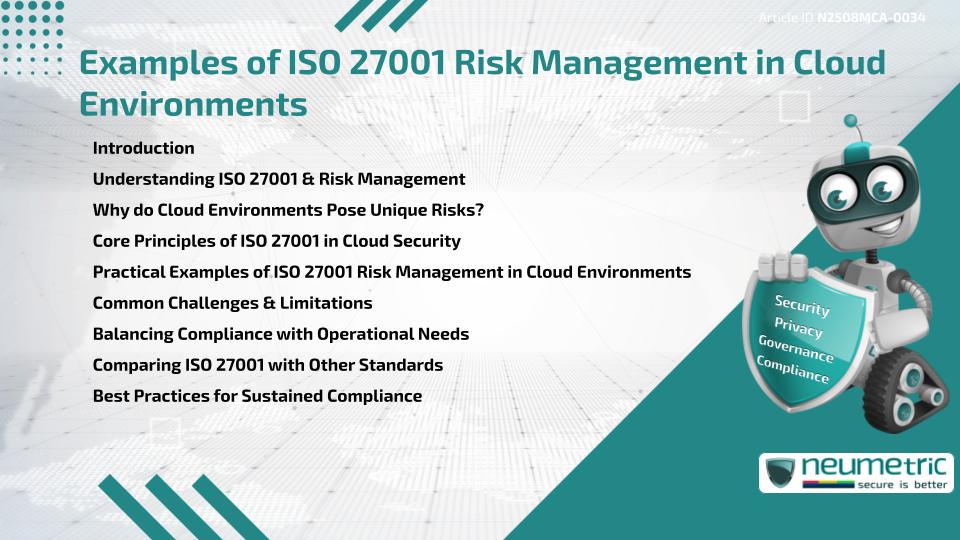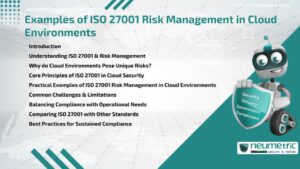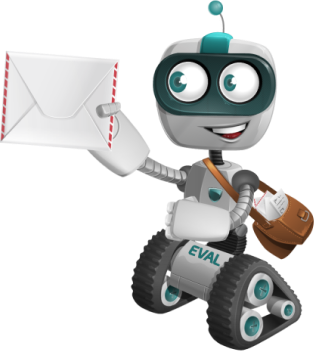Table of Contents
ToggleIntroduction
Examples of ISO 27001 Risk Management in cloud environments showcase how Organisations can apply structured, internationally recognised controls to safeguard data stored & processed in cloud platforms. These examples highlight Risk Assessment, Security Controls, compliance monitoring & continual improvement strategies tailored for the cloud. By understanding how ISO 27001 operates in virtualised infrastructures, Organisations can better protect Sensitive Information, comply with regulatory requirements & mitigate potential security breaches.
This article explores the fundamentals of ISO 27001, the distinct Risks in cloud computing, real-world examples of its application, the challenges faced & the Best Practices to maintain robust security while ensuring operational efficiency.
Understanding ISO 27001 & Risk Management
ISO 27001 is an international Standard for establishing, implementing, maintaining & continually improving an Information Security Management System [ISMS]. It emphasises a systematic approach to managing Sensitive Information through a Risk-based Framework.
Risk Management under ISO 27001 involves identifying assets, assessing Threats & Vulnerabilities, evaluating Risk levels & implementing suitable controls. The aim is to ensure Confidentiality, Integrity & Availability of information, regardless of where it is stored — including in Cloud environments.
Why do Cloud Environments Pose Unique Risks?
Cloud environments introduce Risks different from traditional on-premises infrastructure. Key challenges include:
- Multi-Tenancy: Shared infrastructure can lead to data isolation concerns.
- Third Party Dependencies: Cloud service providers hold significant responsibility for infrastructure security.
- Dynamic Scaling: Frequent changes in resources & configurations increase the attack surface.
- Jurisdictional Complexities: Data stored in different countries may be subject to varying legal requirements.
These Risks require careful alignment of cloud provider practices with ISO 27001 control objectives.
Core Principles of ISO 27001 in Cloud Security
ISO 27001 outlines security principles that are adaptable to cloud environments:
- Asset Identification: Recognising all virtual assets such as virtual machines, storage buckets & cloud applications.
- Access Control: Implementing role-based access to prevent unauthorised activities.
- Cryptographic Controls: Securing data in transit & at rest using encryption.
- Supplier Relationships: Evaluating & managing the security posture of cloud vendors.
- Incident Response: Establishing protocols for identifying, reporting & responding to cloud-based incidents.
Practical Examples of ISO 27001 Risk Management in Cloud Environments
Here are some realistic ways Organisations apply ISO 27001 in the cloud:
- Risk-Based Vendor Selection: Choosing a cloud provider that undergoes independent audits & demonstrates compliance with recognised frameworks.
- Encryption Key Management: Using Hardware Security Modules to control encryption keys rather than leaving them with the provider.
- Regular Vulnerability Assessments: Conducting scheduled penetration tests to uncover weaknesses in cloud-hosted applications.
- Identity Federation: Integrating corporate identity systems with the cloud to centralise access management.
- Backup & Disaster Recovery Testing: Ensuring that recovery objectives meet both ISO 27001 requirements & Business Continuity goals.
Each of these examples reflects how ISO 27001’s controls can be adapted to the unique structure of cloud platforms.
Common Challenges & Limitations
While ISO 27001 provides a strong Framework, applying it to the cloud has hurdles:
- Reliance on Third Party transparency for compliance evidence
- Shared responsibility model ambiguities
- Rapidly changing cloud technologies outpacing control updates
- Higher costs for advanced Security Monitoring Tools
Organisations must balance these challenges against the benefits of cloud agility & scalability.
Balancing Compliance with Operational Needs
Overly rigid implementation can hinder cloud efficiency. For instance, strict Access Controls may delay legitimate development processes. The key is integrating ISO 27001 controls into cloud workflows without creating bottlenecks.
Regular collaboration between security, operations & development teams can ensure controls support rather than obstruct productivity.
Comparing ISO 27001 with Other Standards
ISO 27001 is not the only Framework applicable to Cloud Security. Others include:
- SOC 2: Focuses on service provider controls across security, availability & confidentiality.
- NIST CSF: Provides a flexible approach to managing Cybersecurity Risks.
- CSA STAR: Specifically addresses cloud service security.
Comparing these helps Organisations choose complementary Certifications or frameworks.
Best Practices for Sustained Compliance
To maintain ISO 27001 alignment in cloud environments:
- Conduct regular internal audits focusing on cloud-specific Risks.
- Keep asset inventories current with dynamic resource allocation.
- Train staff on secure cloud usage practices.
- Continuously monitor logs & alerts for suspicious activities.
- Update Risk Assessments in line with business or cloud architecture changes.
Takeaways
- ISO 27001 provides a structured, Risk-based approach to securing cloud environments.
- Practical implementation involves adapting controls to virtual assets & provider relationships.
- Success requires balancing security with operational efficiency.
- Continuous Monitoring, training & updated Risk Assessments sustain compliance.
FAQ
What is ISO 27001 in the context of cloud environments?
It is an international Standard for managing Information Security that can be adapted to safeguard cloud-based assets & processes.
How does ISO 27001 handle shared responsibility in the cloud?
It requires clear definition of roles between the organisation & the provider, supported by contracts & Service-Level Agreements.
Can Small Businesses apply ISO 27001 to cloud systems?
Yes, the Standard is scalable & can be tailored to the size & complexity of any Organisation.
What are the benefits of applying ISO 27001 in cloud environments?
They include enhanced Data Protection, improved compliance, stronger Incident Response & better Vendor Risk Management.
How often should cloud Risk Assessments be done under ISO 27001?
They should be conducted at least annually or whenever significant changes occur in the cloud environment.
Is encryption mandatory under ISO 27001 for cloud data?
It is not mandatory but is a highly recommended control for securing Sensitive Information in transit & at rest.
How does ISO 27001 differ from SOC 2 in cloud Risk Management?
ISO 27001 focuses on a complete ISMS, while SOC 2 evaluates specific control categories relevant to service providers.
Need help for Security, Privacy, Governance & VAPT?
Neumetric provides organisations the necessary help to achieve their Cybersecurity, Compliance, Governance, Privacy, Certifications & Pentesting needs.
Organisations & Businesses, specifically those which provide SaaS & AI Solutions in the Fintech, BFSI & other regulated sectors, usually need a Cybersecurity Partner for meeting & maintaining the ongoing Security & Privacy needs & requirements of their Enterprise Clients & Privacy conscious Customers.
SOC 2, ISO 27001, ISO 42001, NIST, HIPAA, HECVAT, EU GDPR are some of the Frameworks that are served by Fusion – a SaaS, multimodular, multitenant, centralised, automated, Cybersecurity & Compliance Management system.
Neumetric also provides Expert Services for technical security which covers VAPT for Web Applications, APIs, iOS & Android Mobile Apps, Security Testing for AWS & other Cloud Environments & Cloud Infrastructure & other similar scopes.
Reach out to us by Email or filling out the Contact Form…





